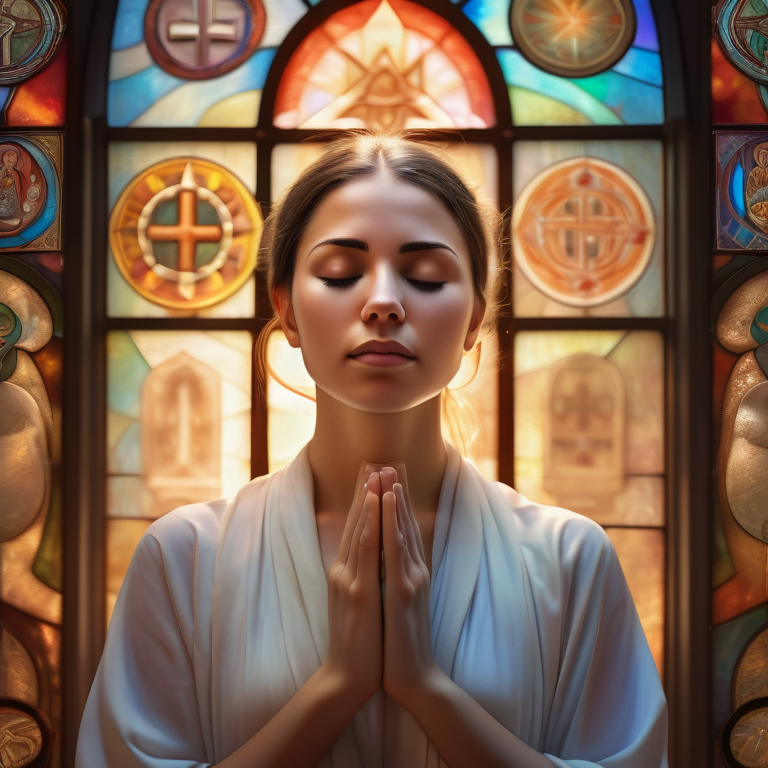Women’s Sexuality and Religion: A Global Overview

Key Highlights
- Ancient religious practices and beliefs have shaped the perception of femininity in various religious traditions.
- Gender roles in major world religions have evolved over time, with some becoming more inclusive while others maintain traditional norms.
- Christianity has a complex relationship with sexual morality, with diverse interpretations and practices among its followers.
- Islam grapples with the balance between tradition and modernity in regards women’s sexuality.
- Hinduism celebrates the divine feminine and acknowledges the role of sexuality in spiritual practice.
- Buddhism emphasizes the concept of desire and its implications for women’s sexuality.
Introduction
Religion and sexuality are two deeply personal aspects of human identity, and their intersection has shaped societies and individuals throughout history. Women, in particular, have often been at the center of discussions about sexuality and religion, as societal attitudes and religious beliefs have both influenced and constrained their sexual autonomy. Understanding the historical and cultural context of women’s sexuality within different religious traditions, as well as the impact of factors such as gender, age, and ethnicity, is essential to gaining insight into the complexities of this relationship and the importance of religion in shaping women’s lives. This is where the field of sociology comes into play, as it offers a unique perspective on the intersection of religion and sexuality and how it impacts individuals and society as a whole.
Throughout the ages, ancient religious practices have influenced beliefs about femininity. These beliefs have shaped the roles and expectations placed on women within religious communities. Over time, gender roles within major world religions have evolved, reflecting changing societal norms and interpretations of religious texts. Christianity, Islam, Hinduism, and Buddhism each have unique perspectives on women’s sexuality, with varying beliefs and practices observed in different regions, including Europe. In this guide, we will explore these perspectives in more detail, focusing on the impact of religious beliefs on women’s sexuality and marital relationships, including the gender gap in regular attendance at religious services, specifically the communal Friday midday prayers for Muslim men, using data and research from the Pew Research Center.
In recent years, the challenges and conflicts surrounding women’s sexuality within religious contexts have become more prominent. Religious conservatism often clashes with movements advocating for sexual rights and gender equality. Feminism has played a significant role in redefining women’s roles within religious communities and challenging traditional norms. Legal battles over reproductive rights have also raised questions about the influence of religious perspectives on women’s autonomy.
To gain a comprehensive understanding of the global landscape of women’s sexuality and religion, we will explore the historical intersection of religion and women’s sexuality, conduct a comparative analysis of women’s sexuality within different religions, examine contemporary challenges and conflicts, and delve into personal narratives of women navigating sexuality and faith. We will also explore the role of religious institutions in shaping attitudes towards women’s sexuality and the potential for open dialogue within these spaces, taking into account observed differences and statistical significance in our analysis.
The Historical Intersection of Religion and Women’s Sexuality
Ancient religious practices often shaped beliefs about femininity, influencing gender roles within various world religions. The evolution of these roles reflects complex relationships between women’s sexuality and religious doctrines. Over time, this historical intersection has impacted women’s autonomy and rights globally. Understanding these dynamics is crucial for appreciating the cultural and social contexts that continue to shape contemporary perspectives on women’s sexuality and religion.
Ancient Religious Practices and Beliefs About Femininity
Throughout history, ancient religious practices have shaped beliefs regarding femininity. In many cultures, women were often associated with concepts of fertility, nurturing, and household roles, reflecting prevailing societal norms. These beliefs influenced various rituals and customs, emphasizing the importance of women within religious contexts. Understanding these ancient perspectives provides insight into the foundations of how women’s sexuality and identity have been perceived through a religious lens, setting the stage for evolving interpretations in modern times.
Evolution of Gender Roles Within Major World Religions
Within major world religions, the evolution of gender roles has been a nuanced process shaped by historical contexts and interpretations of sacred texts. In Christianity, for example, traditional gender roles emphasizing male leadership have been challenged by movements advocating for gender equality. Similarly, in Islam, there are ongoing discussions about the roles of women in society and religious practices, with previous studies showing varying levels of religious commitment between men and women. Hinduism and Buddhism also exhibit diverse perspectives on gender roles, reflecting the complex interplay between religious beliefs and cultural norms. The evolution of gender roles within these religions, including in regions such as Africa, continues to be a subject of scholarly inquiry.
Comparative Analysis of Women’s Sexuality in Different Religions
Christianity offers varying perspectives on women’s sexuality, with traditional views on modesty and purity but also evolving interpretations. Islam navigates between honoring modesty and addressing sexual rights for women. Hinduism embraces the concept of the divine feminine and grants women spiritual significance. Buddhism explores desire and its implications for women’s liberation. Each religion presents a unique stance on women’s sexuality, reflecting the diverse intersections between faith, culture, and human rights.
Christianity and Sexual Morality: A Complex Relationship
Within Christianity, the relationship between sexual morality and religious teachings is intricate. Biblical scriptures, societal norms, and historical interpretations all influence how this connection is perceived. The concept of sin, purity, and righteousness plays a significant role in shaping attitudes towards women’s sexuality within Christian communities. The interplay between religious doctrines and individual beliefs often leads to nuanced discussions on topics such as premarital sex, contraception, and gender roles. Christ’s teachings on love, compassion, and forgiveness also intersect with the moral frameworks surrounding sexuality in Christian contexts.
Islam and Women’s Sexuality: Between Tradition and Modernity
Within Islam, women’s sexuality navigates a delicate balance between tradition and modernity. Islamic teachings often emphasize modesty and chastity, rooted in historical and cultural norms. However, contemporary interpretations strive to reconcile these principles with evolving societal attitudes towards women’s rights and autonomy. Muslim women face the challenge of upholding religious values while embracing individual empowerment and sexual freedom, reflecting the ongoing dialogue within Islamic communities on the intersection of faith and personal expression.
Hinduism, Sexuality, and the Divine Feminine
In Hinduism, sexuality intertwines with the concept of the divine feminine, embodying both creative and nurturing aspects. Hindu traditions recognize feminine energy as a force of power and wisdom, present in deities like Parvati and Kali. The ancient texts depict stories where sexuality is not separate from spirituality but rather a natural and revered facet of existence, emphasizing balance and harmony in relationships and cosmic energies. Hinduism celebrates the unity of sexuality and spirituality through rituals, festivals, and philosophical discussions.
Buddhism and the Concept of Desire: Implications for Women
In Buddhism, desires are often viewed as fundamental causes of suffering, leading to the concept of detachment from earthly desires. This standpoint presents both challenges and opportunities for women regarding their sexuality. The emphasis on controlling desire in Buddhist teachings can influence how women navigate their sexual autonomy and relationships, shaping their identities within the context of desire and self-discovery. Buddhism’s unique perspective on desire offers insights into the interplay between women’s sexuality and spiritual liberation.
Contemporary Challenges and Conflicts
The intersection of women’s sexuality and religion presents contemporary challenges and conflicts globally. Religious conservatism often impedes women’s sexual rights, contrasting with the modern quest for autonomy. Feminism’s dialogue with religious norms further complicates this landscape, while legal battles over reproductive rights reflect the conflict of values. Balancing tradition and progression, these issues highlight the ongoing struggle for women to assert sexual agency within the bounds of religious doctrines.
The Impact of Religious Conservatism on Women’s Sexual Rights
In many societies, religious conservatism significantly influences women’s sexual rights, often shaping restrictive norms and practices. This impact can manifest through limitations on reproductive autonomy, contraception use, and access to comprehensive sexual education. Women may face challenges in asserting their sexual agency due to these deeply ingrained beliefs. Religious conservatism, or the degree of religiosity, can intersect with cultural traditions, resulting in a complex web of influences on women’s sexual rights, including higher levels of current religiosity leading to a greater likelihood of remaining abstinent, but a lower likelihood of using pregnancy prevention methods in the United States. It is crucial to address these intersections to promote gender equality and advocate for women’s autonomy over their sexual health and choices.
Feminism, Religion, and the Quest for Sexual Autonomy
Feminism, religion, and the quest for sexual autonomy intersect in complex ways, reflecting evolving societal norms and individual rights. Women worldwide navigate the delicate balance between religious teachings and personal empowerment. Religious traditions often influence perspectives on gender equality and sexual autonomy, sparking dialogues on human rights and social justice. The pursuit of sexual autonomy within diverse religious contexts underscores the ongoing struggle for women’s empowerment and self-determination. Approached with an open mind, this intersection offers insights into the dynamic relationship between faith, feminism, and personal agency.
Legal Battles Over Reproductive Rights: A Religious Perspective
Legal battles over reproductive rights from a religious perspective showcase the ongoing tension between individual freedoms and religious doctrines. Different world religions often have varying viewpoints on issues such as abortion and contraception, with India being one of the countries where these debates are particularly prevalent. Recent developments in human rights have further heightened these discussions, with religious traditions influencing legal frameworks. Understanding these dynamics requires a nuanced analysis that considers both the rights of individuals and the beliefs of religious institutions. In navigating these conflicts, it is crucial to strike a balance that respects both personal autonomy and religious values.
Case Studies: Women Navigating Sexuality and Faith
Personal narratives from Christian women, Muslim women’s experiences balancing faith and freedom, and Jewish women discussing sexuality within orthodoxy are enlightening case studies. These real-life stories offer valuable insights into how women reconcile their religious beliefs with their sexuality. By exploring these diverse perspectives, we gain a deeper understanding of the complexities and challenges faced by women navigating the intersection of faith and sexual identity. These case studies highlight the nuanced ways in which women from different religious backgrounds grapple with issues of sexuality and faith.
Personal Narratives from Christian Women
Exploring personal narratives from Christian women offers valuable insights into the intersection of women’s sexuality and religious beliefs. These stories often showcase the diverse ways in which individuals navigate and reconcile their faith with their sexual identities. Through these narratives, we witness the complex and nuanced experiences that Christian women encounter, shedding light on the challenges, triumphs, and evolving perspectives within the realm of women’s sexuality and religion. These individual accounts contribute to a richer understanding of the dynamics at play within this context.
Muslim Women’s Experiences: Between Faith and Freedom
In navigating their identities, Muslim women often find themselves balancing the intricacies of faith and the desire for personal autonomy. The intersection of religious teachings with modern societal norms poses a unique challenge, shaping their experiences around sexuality. From issues of modesty to interpretations of gender roles, Muslim women’s journeys embody a delicate negotiation between adhering to traditional values and asserting individual freedoms. This complex interplay highlights the nuanced ways in which women within Islamic communities navigate the waters of faith and personal agency.
Jewish Women Discussing Sexuality and Orthodoxy
Orthodox Jewish women face unique challenges when discussing sexuality within the bounds of their faith. Navigating between traditional beliefs and modern perspectives, these women often find themselves in a delicate balance influenced by religious teachings and societal norms. Initiating frank conversations about sexuality can be especially complex within orthodox communities, where modesty and privacy are highly valued. Exploring these intersections provides valuable insights into the diverse experiences and perspectives of Jewish women grappling with issues of sexuality within the framework of orthodoxy.
The Role of Religious Institutions
Religious institutions play a crucial role in shaping attitudes towards women’s sexuality globally. They are influential in educating on sexuality and guiding believers in moral conduct. The Church, mosques, temples, and synagogues serve as spaces for dialogue and reflection on sexual norms and religious affiliation. Religious leaders have the opportunity to advocate for human rights and support sexual autonomy while respecting traditional values. Their teachings can impact family dynamics and societal views on women’s sexuality, highlighting the importance of their role in fostering respectful and informed discussions on a variety of measures.
Educating on Sexuality: What Can Religious Leaders Do?
Religious leaders can educate their communities on sexuality by promoting open discussions, providing accurate information, and supporting individuals’ autonomy. They can address stigmas and emphasize respect and consent in relationships, contributing to a more informed and inclusive society.
The Church’s Response to Changing Sexual Norms
In response to changing sexual norms, the church is encountering a shift in attitudes towards sexuality. Traditional views are being reexamined as society evolves. Religious institutions are navigating how to adapt while remaining true to their beliefs. The church is engaging in dialogues on topics that were once deemed taboo, seeking to find a balance between doctrine and societal changes. As these discussions unfold, the church’s response to evolving sexual norms and its impact on the relationships between its followers and family members continues to shape its relationship with its followers and the broader community.
Mosques, Temples, and Synagogues: Spaces for Open Dialogue?
Religious institutions like mosques, temples, and synagogues serve as potential spaces for open dialogue on women’s sexuality within the framework of faith. These places offer opportunities for conversations that blend religious teachings with modern perspectives.
Conclusion
The exploration of women’s sexuality and its intersection with religion unveils a rich tapestry of historical, social, and cultural nuances. As we navigate through ancient beliefs, modern challenges, and personal narratives, it becomes evident that the dialogue surrounding women’s sexuality is multifaceted and often reflective of larger societal dynamics. By delving into comparative analyses of different religions, understanding contemporary conflicts, and examining the role of religious institutions, we gain insights into the complexities and possibilities for progress in this realm. The voices of women, their experiences, and the evolving landscapes of faith and sexuality collectively shape a narrative that is both compelling and thought-provoking. Share your thoughts and reflections by commenting below as we continue this dialogue with respect and empathy.
Frequently Asked Questions
How do different religions view female sexuality?
Ancient religious beliefs often shaped views on femininity. Christianity emphasizes sexual morality, while Islam balances tradition with modernity. Hinduism reveres the divine feminine, and Buddhism addresses desire’s impact on women. Each religion influences how female sexuality is perceived globally.
Can a woman be religious and sexually liberated?
In the context of varying religious beliefs, the question of whether a woman can be both religious and sexually liberated is complex. It involves navigating traditional norms and personal autonomy, reflecting the evolving intersections of faith and sexuality.
As this topic is sensitive and requires a nuanced approach, the following questions are crafted to address it respectfully:
H2/H3: As this topic is sensitive and requires a nuanced approach, the following questions are crafted to address it respectfully.
How do different religious beliefs around the world influence attitudes towards women’s sexuality?
Different religious beliefs globally shape views on women’s sexuality, reflecting diverse norms and teachings. Christianity, Islam, Hinduism, and Buddhism each impact attitudes differently, influencing societal perceptions and individual expressions of female sexuality. Understanding these influences is crucial in addressing societal dynamics and promoting gender equality.
How have historical interpretations of religious texts shaped societal views on women’s sexuality?
Historical interpretations of religious texts have significantly influenced societal perceptions of women’s sexuality. From ancient beliefs about femininity to modern debates on sexual autonomy, these interpretations continue to impact cultural norms and values surrounding women’s sexuality worldwide.
Are there common themes or differences in how various religions view women’s sexuality?
Ancient religious beliefs shaped views on femininity, impacting gender roles in major religions. Christianity, Islam, Hinduism, and Buddhism have diverse perspectives on women’s sexuality. Balancing tradition and modernity, these faiths influence women’s sexual rights differently. Contemporary challenges reflect this intricate relationship.
What are some current debates or discussions within different religious communities regarding women’s sexuality?
Various religious communities debate women’s sexuality, exploring topics like reproductive rights in Christianity, modesty in Islam, divine femininity in Hinduism, and desires in Buddhism. These discussions reflect the intersection of faith and gender roles.





